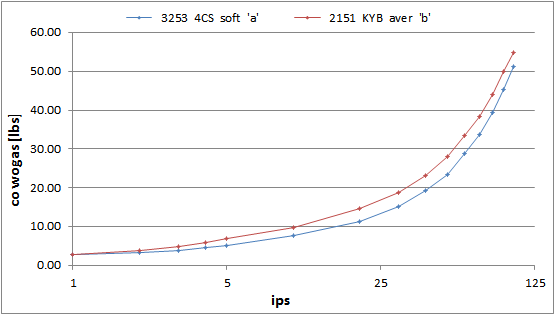- Compression zeta (c-zeta) is used to create target damping curves for both bv and mv compression force.
- The bv and mv force is reverse engineered from the curve, then 2 lbs of target drag is added.
- This = co wogas [target].
- There are currently three c-zeta damping curves. We simply call them 'a', 'b', 'c'.
- Curve 'a' (blue) is from (3253)f 4CS fork. This fork works extremely well.
- 'a' is softer than 'b' from 3-60ips, crosses over about 70ips then amps up more as velocities increase.
- This is due to the 20mm mv piston and small mv ports.
- Curve 'b' (red) is from (2151)f KYB forks.
- 'b' is stiffer at 3-60ips, then the comp force drops off as velocities increase.
- This is because the KYB fork has larger mv piston with larger mv ports.
| probably 4CS only | KYB | ||||
| ips | bv aver a x 1.0 | mv aver a x 1.0 | bv aver b x 1.0 | mv aver b x 1.0 | |
| 3 | 2 | .1 | 2.8 | .1 | |
| 10/20 | 5.6 | 2.2 | 6.9 | 3 | |
| 70 | 16.7 | 19.4 | 16.6 | 19.5 | |
| 100 | 20.9 | 35.2 | 20.2 | 32.2 | |
| 150 | 28 | 62 | 26 | 53 | |
| 400 | 66 | 195 | 57 |
158 | |

- Here is another look at curves 'a' and 'b'.
- This compares soft 'a' vs aver 'b'.
- They start about the same at 1-2ips, then blue curve 'a' is softer and it will eventually catch and pass red curve 'b' at about 120ips.
